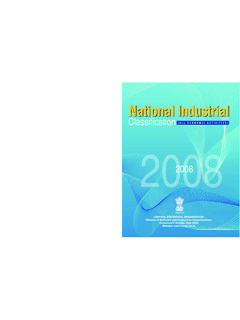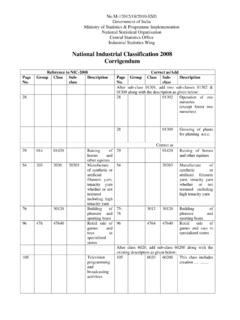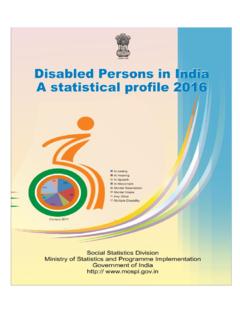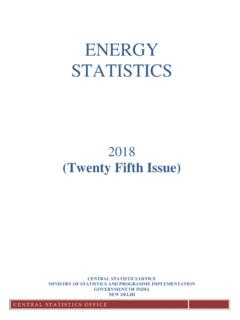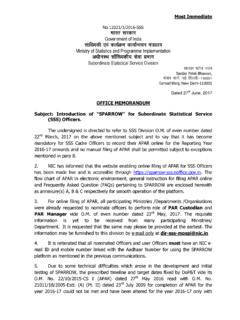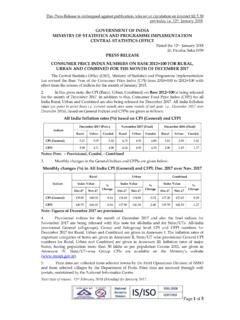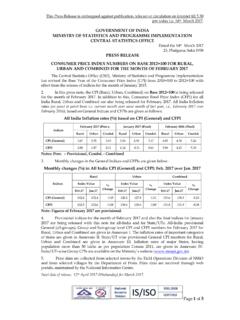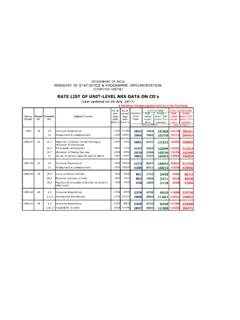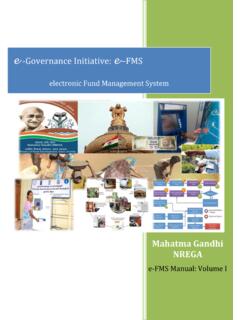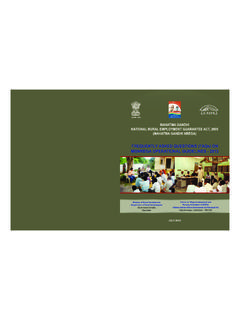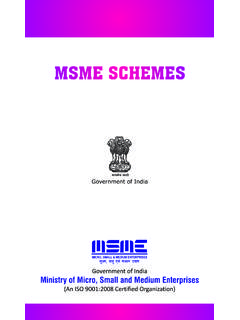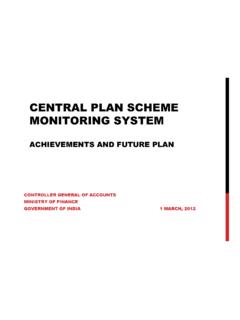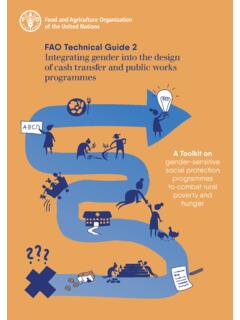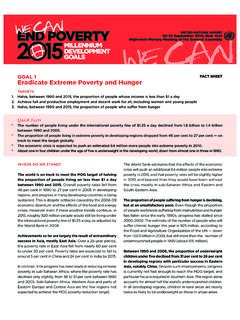Transcription of YOUTH IN INDIA
1 YOUTH IN INDIA . 2017. Central Statistics Office Ministry of Statistics and Programme Implementation Government of INDIA (Social Statistics Division). OFFICERS ASSOCIATED WITH THE. PREPARATION OF THIS PUBLICATION. Deputy Director General Dr. Davendra Verma Panchanan Dash Director Mitter Sain Deputy Director Soumya P Kumar Junior Statistical Officer Chandra Prakash Ravi Kumar Personal Assistant Kesan Social Statistics Division Central Statistics Office Ministry of Statistics & Programme Implementation West Block-8, Wing-6, Puram, New Delhi-110066. CONTENTS. PART I YOUTH AN OVERVIEW. Highlights i-ii i. Introduction 1. ii. YOUTH Concepts and Definition INDIA and the World 2. iii. Major Issues Concerning YOUTH 3-7. 1. Education 3-4. 2. employment 5. 3. Civic Engagement 6.
2 4. Migration 7. PART-II - VITAL AND SOCIAL STATISTICS OF YOUTH IN INDIA . i. YOUTH Population and its Dynamics 8-18. YOUTH in INDIA 1. Population Growth and Projections by Sex 8-9. 2. Average Annual Growth Rate Gender wise 10. 3. YOUTH Population (15-34 years) and their share to total Population 11-12. 4. Distribution of Population by Age and Sex 13-14. INDIA and the World 5. Population: World, INDIA and its share 1970-2030 15. Regional Demographic Trends 6. Share of YOUTH Population (15-34 Years), Sex wise, Continents wise, Developed Regions and World (1970-2030) 16. Trends within Asia 7. Share of YOUTH Population (15-34 Years), in Major Countries of Asia (1970-2030) 17. 8. Share of YOUTH Population (15-34 Years) Sex wise, in Major Countries of Asia (1970-2020) 18.
3 Ii. Marital Statistics 19-21. 9. Percentage of Currently Married Females to all Females for Different Age-Group 19. 10. Mean Age of Females at Effective Marriage; All INDIA and Major States 20. 11. Number of Married Couples, with Wifes' Age between 15-44 Years 21. iii. Fertility & Contraception 22-26. Fertility 12. Average Number of Children Born Per Woman by Age 22. 13. Age Specific Fertility Rates 23-24. Population Control 14. Percentage of Currently Married Women in 15-49 Age Group Who Want No More Children by Number of Living Children 25. 15. Percentage of Currently Married Women in INDIA in 15-34 Age Group by Currently Used Contraceptive Methods, 1998-99 & 2005-06 26. iv. Mortality and Neonatal Health Care 27-30. Mortality 16. (a). Age Specific Mortality Rates Total 27.
4 16. (b). Age Specific Mortality Rates Rural 28. 16. (c). Age Specific Mortality Rates Urban 28. Medical care at delivery 17. Percent distribution of live births by type of Medical Attention received by the mother at the time of delivery 29. Pregnancy related deaths 18. Percentage of deaths due to Complication of Pregnancy, Childbirth and the Puerperium 30. v. Literacy and employment 31-42. Literacy 19. Percentage of Literate by age and Sex 31. Student Enrolment in Higher Education 20. Number of Students Enrolled at various levels in Higher Education 32. Higher Education Institutions 21. Institutions of Higher Education in INDIA 33. Indian Students Studying abroad 22. Indian Students Studying abroad 34. employment and Labour Force Participation 23. (a).
5 Labour Force Participation Rates (Rural) by age as Per Various Rounds of NSSO 35. 23. (b). Labour Force Participation Rates (Urban) by age as Per Various Rounds of NSSO 36. Unemployment 24. (a). Unemployment Rates (Rural) by age as Per Various Rounds of NSSO 37. 24. (b). Unemployment Rates (Urban) by age as Per Various Rounds of NSSO 38. Minimum Wages 25. Minimum Wages for the employment for which Central Government has fixed Wages Under the MW Act, 1948 39-41. 26. Minimum Rates of wages for the Unskilled Workers in Different States/ UTs 42. vi. Crime and YOUTH 43-46. Juvenile Delinquency 27. Juvenile Delinquency, 2000 - 2015 44. Suicides 28. Incidences of Suicides in various age groups -2015 45. Incidences of Rape 29. Victims of Rape by Age Group, 2000 - 2015 46.
6 PART-III - WELFARE OF YOUTH IN INDIA . A. Policy Initiatives for YOUTH in INDIA 47-50. B. Government Programmes for YOUTH in INDIA 1. National Young Leaders Programme (NYLP) 50-51. 2. Nehru Yuva Kendra Sangathan (NYKS) 51-52. 3. National Service Scheme (NSS) 53. 4. Rajiv Gandhi National Institute of YOUTH Development (RGNIYD) 53-54. 5. National Programme for YOUTH and Adolescent Development (NPYAD) 54. 6. YOUTH Hostels 55. 7. Assistance to Scouting and Guiding Organisations 55. C. Skill Development of YOUTH 8. Mahatma Gandhi National Rural employment Guarantee Act (MGNREGA ) 55. 9. Deen Dayal Upadhyaya Grameen Kaushalya Yojna (DDU-GKY) 56. 10. Deen Dayal Antayodaya Yojana - National Rural Livelihoods Mission (DAY-NRLM) 56-58. 11. Prime Minister's employment Generation Programme (PMEGP) 58.
7 12. Enterprise and Skill Development 59-60. 13. Assistance to Training Institutions (ATI) Scheme 60. 14. Pradhan Mantri Kaushal Vikas Yojana (PMKVY) 61. 15. UDAAN 61. PART IV - INTERNATIONAL INITIATIVES FOR YOUTH 62-75. 1. UN's Department of Economic and Social Affairs (DESA) 63-64. 2. UN Centre for Human Settlements (HABITAT) 64. 3. United Nations Development Programme (UNDP) 64-65. 4. United Nations Environment Programme(UNEP) 65-66. 5. United Nations Population Fund (UNFPA) 66. 6. United Nations Children's Fund (UNICEF) 66-67. 7. United Nations Programme on HIV/AIDS (UNAIDS) 68. 8. International Labour Organisation (ILO) 68-69. 9. Food and Agriculture Organization of the United Nations (FAO) 69-70. 10. United Nations Educational, Scientific and Cultural Organization (UNESCO) 71-72.
8 11. United Nations Volunteers (UNV) 72. 12. United Nations alliance of civilizations (UNAOC) 72-73. 13. United Nations Office on Drugs and Crime (UNODC) 73. 14. UN Department of Public Information (DPI) 73-74. 15. The World Programme of Action for YOUTH (WPAY) 74-75. References 76. Highlights The publication YOUTH in INDIA attempts to identify the issues of importance for YOUTH under the broad categories- Population dynamics, marital statistics, fertility & contraception, Mortality & Neonatal Health care, Literacy & employment and Crime. Attempt has been made to incorporate relevant indicators on these identified aspects and the latest available data on these indicators. The report also incorporates a synopsis of the on-going schemes and programmes for the welfare of YOUTH in INDIA .
9 An overview of United Nations YOUTH related initiatives/programmes are also included in the report. The National YOUTH Policy (NYP-2014) launched in February 2014. proposes a holistic vision' for the YOUTH of INDIA , which is To empower YOUTH of the country to achieve their full potential, and through them enable INDIA to find its rightful place in the community of nations . The NYP-2014 has defined YOUTH ' as persons in the age-group of 15-29. years. Government of INDIA has formulated the National Policy for Skill Development and Entrepreneurship in 2015 to provide an umbrella framework to all skilling activities being carried out within the country, and to align these to common standards and link skilling with demand centres. INDIA has the relative advantage at present over other countries in terms of distribution of YOUTH population.
10 As per INDIA 's Census, the total YOUTH population increased from 168 million in 1971 to 422 million in 2011. INDIA is seen to remain younger longer than China and Indonesia, the two major countries other than INDIA which determine the demographic features of Asia. A negative aspect of YOUTH in INDIA is that the sex ratio in YOUTH population is consistently decreasing from 1991 onwards. The reduction in sex ratio of YOUTH is found to be much more than that of the overall population. It has come down to 939 in 2011 as compared to 961 in 1971. and is projected to decline further to 904 in 2021. The percentage share of currently married female in the age group 15-19. has come down drastically from in 1961 to in 2011 showing a welcome shift in the level of married women in younger age groups.

